Introduction: Why Tour Miami’s Art Deco and Ocean Drive?
Miami’s Art Deco District and Ocean Drive stand as two of the city’s most recognizable destinations. They offer a vibrant mix of history, architecture, and culture that attracts millions each year. Touring these areas allows us to appreciate the unique charm that sets Miami apart from any other American city.
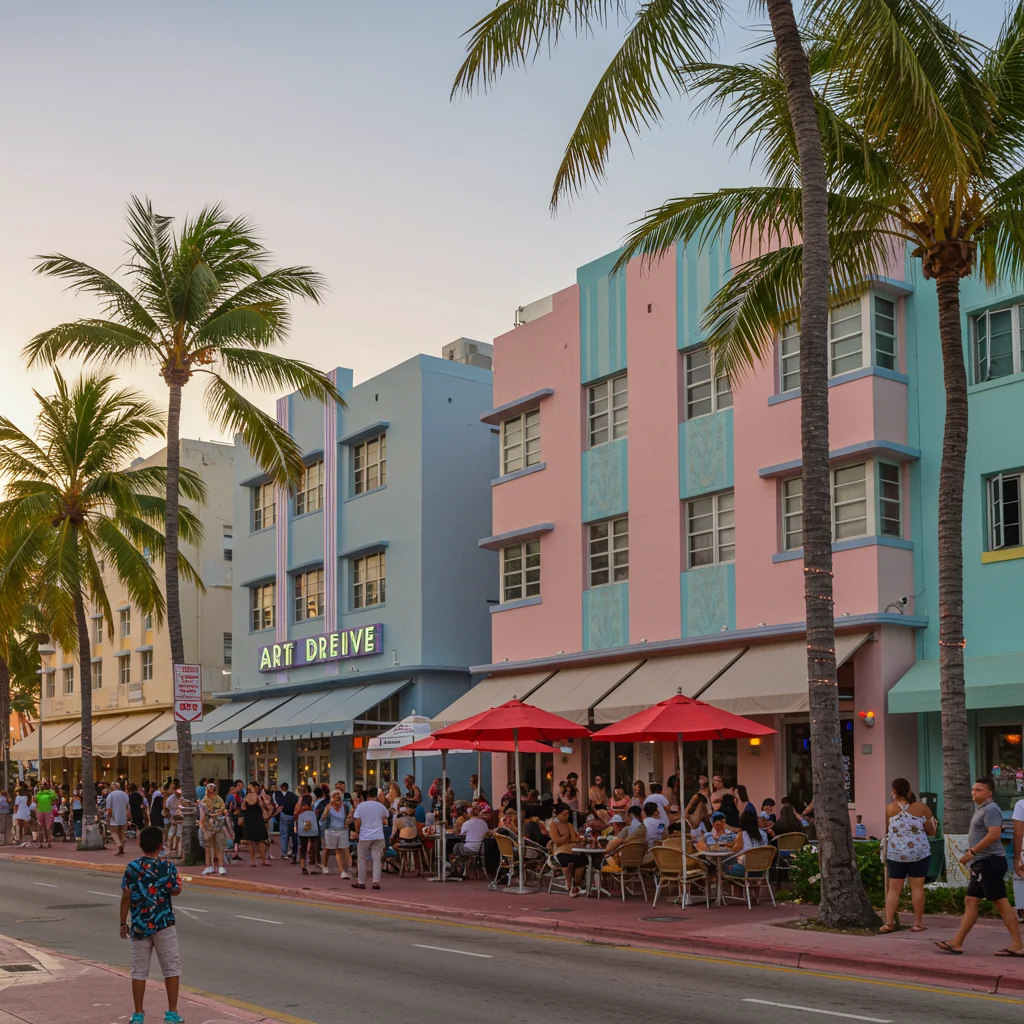
From pastel-colored facades to the unmistakable energy of South Beach, the Art Deco District and Ocean Drive invite us to step into a world where glamour and history coexist. Whether we are architecture enthusiasts, history buffs, or simply seeking a lively atmosphere, this part of Miami has something for everyone.
In this guide, we will provide a comprehensive look at what makes Miami’s Art Deco and Ocean Drive so special. We will share practical advice, must-see sights, and insider tips to help us make the most of our visit.
What Makes Miami’s Art Deco District Unique?
The Art Deco District in Miami Beach is unlike any other historic area in the United States. Its collection of over 800 preserved buildings features a distinct architectural style that cannot be found elsewhere at such a scale. This district is a visual feast, with its array of pastel hues, geometric patterns, and tropical motifs.
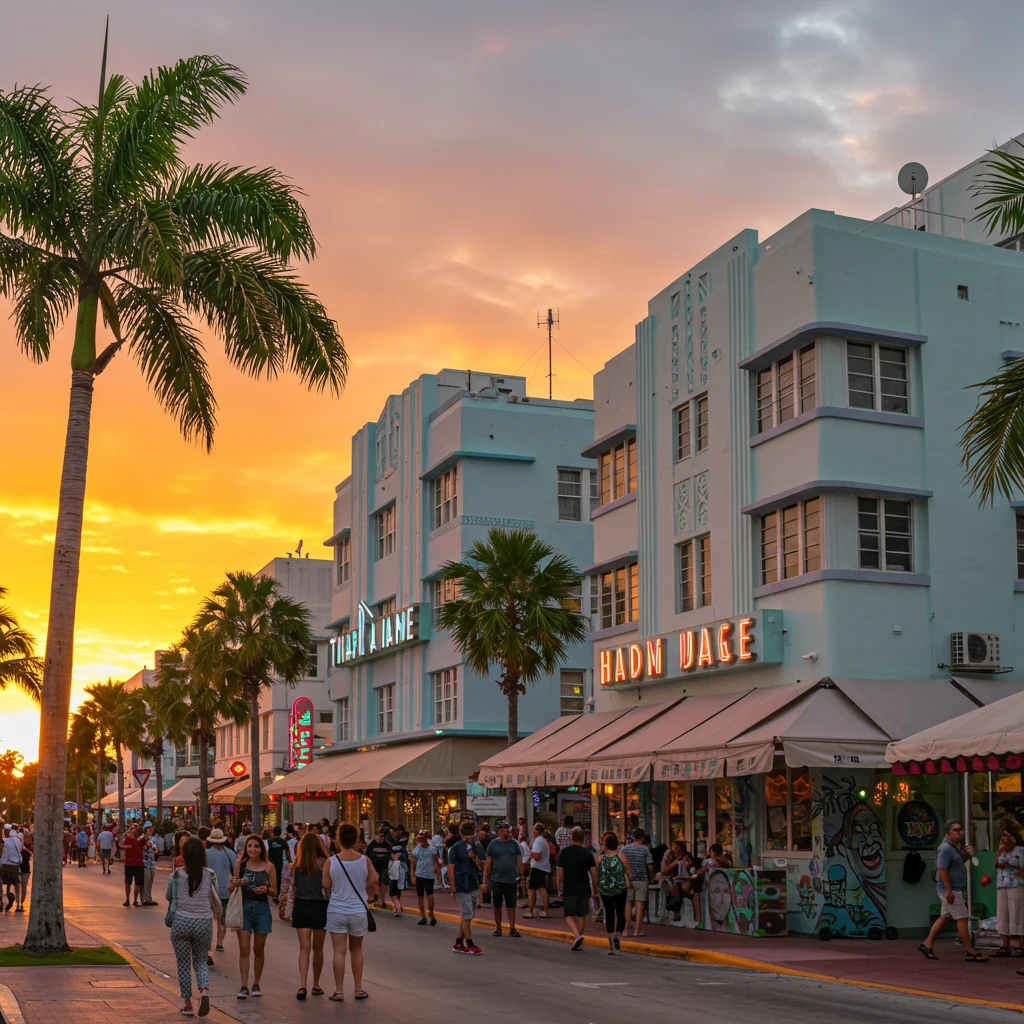
What truly sets Miami’s Art Deco District apart is its harmonious blend of architecture and lifestyle. The buildings are not just relics to admire from afar; they house hotels, restaurants, shops, and nightclubs that remain integral to Miami’s daily life. The district pulses with energy, especially along Ocean Drive.
We find a living, breathing neighborhood where history and modernity intersect. This makes the Art Deco District not only a destination for sightseeing but a place to experience Miami’s spirit firsthand.
A Brief History of Art Deco in Miami
Art Deco architecture arrived in Miami during the 1920s and 1930s, a period when the city was rapidly developing as a resort destination. The style, which originated in Europe, took on a new character in Miami, reflecting the city’s tropical climate and optimistic outlook.
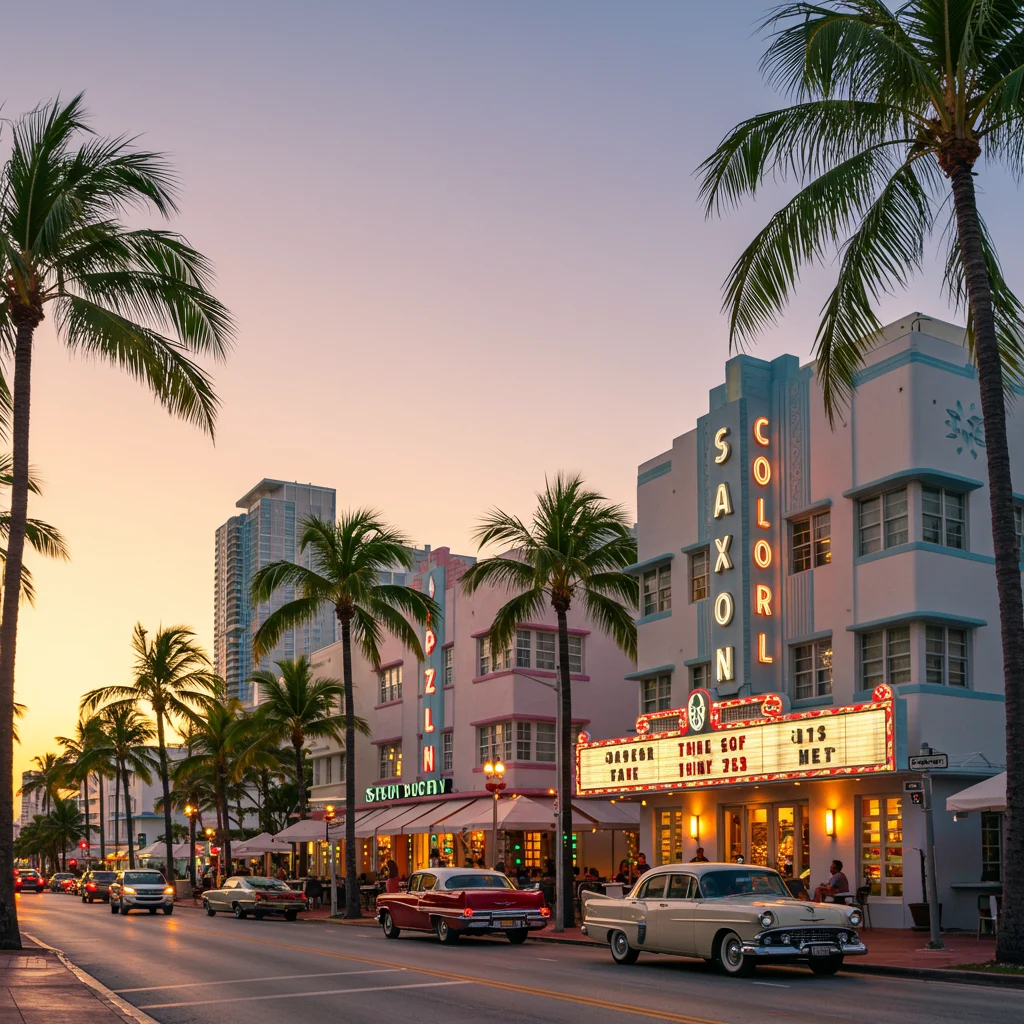
Many of the iconic buildings we see today were constructed during the post-Depression era, when Miami sought to reinvent itself. Architects such as Henry Hohauser and L. Murray Dixon played critical roles, adapting the Art Deco style with pastel colors, nautical motifs, and streamlined forms suited to the beachside environment.
Thanks to preservation efforts in the late 20th century, much of this architectural heritage remains intact. The district was placed on the National Register of Historic Places in 1979, ensuring that future generations can appreciate its unique character.
How Did Ocean Drive Become an Iconic Destination?
Ocean Drive has evolved from a quiet beachfront road into one of the most famous streets in America. Its transformation began in the early 20th century, as Miami Beach became a popular retreat for the wealthy. The construction of Art Deco hotels along the avenue quickly established Ocean Drive as the heart of Miami Beach’s social scene.
![]()
Throughout the decades, Ocean Drive has played host to celebrities, artists, and international visitors. Its colorful buildings and lively atmosphere have made it a favorite backdrop for films, television, and music videos. Today, Ocean Drive is synonymous with Miami’s image, drawing crowds day and night for its entertainment, dining, and vibrant street life.
The street’s enduring appeal lies in its ability to balance history with modern excitement. Whether we are admiring the architecture, enjoying a meal with a view, or simply people-watching, Ocean Drive promises a memorable Miami experience.
Planning Your Miami Art Deco and Ocean Drive Tour
Before setting out to enjoy Miami’s Art Deco District and Ocean Drive, it helps to plan ahead. This ensures we make the most of our time and avoid common pitfalls such as parking hassles or overcrowding. Thoughtful planning lets us focus on the sights and experiences that matter most.
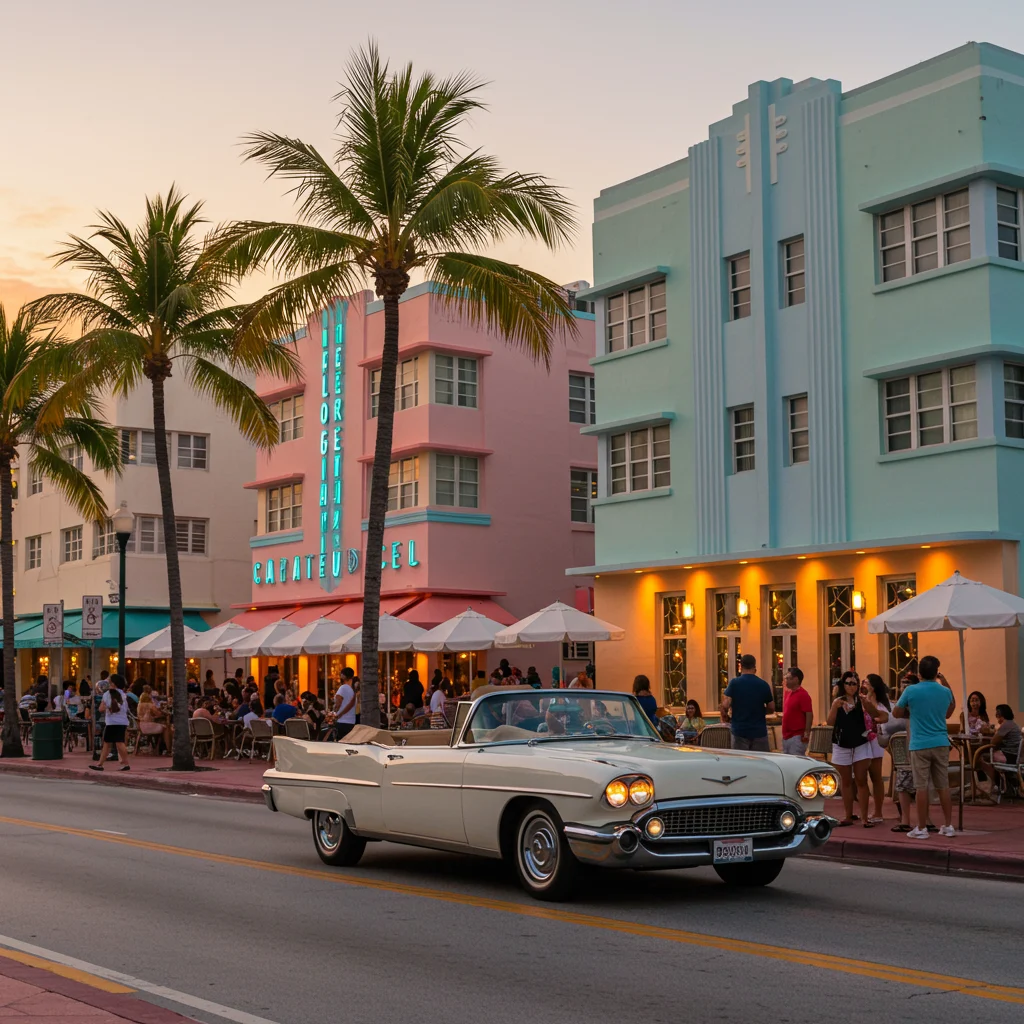
We should consider when to visit, how to reach the district, and where to stay. Each of these factors can influence the quality of our trip and the memories we take home.
When Is the Best Time to Visit Miami’s Art Deco District?
Miami’s warm climate makes the Art Deco District a year-round destination. However, some seasons offer better conditions for sightseeing and outdoor activities. The winter months, from November to April, are considered peak season due to mild temperatures and low humidity.
Visiting during this period means more comfortable walks and fewer chances of rain disrupting our plans. Crowds can be larger, especially during holidays and major events, but the festive atmosphere adds to the area’s appeal.
For those seeking quieter streets and lower hotel rates, the summer and early fall months are also suitable. Just be prepared for higher humidity and occasional afternoon showers.
How to Get to Ocean Drive and the Art Deco District
Reaching Ocean Drive and the heart of the Art Deco District is straightforward. Miami International Airport is just a short drive away, offering convenient access for out-of-town visitors. From the airport, taxis, ride-sharing services, and public buses can all bring us directly to South Beach.
For those staying elsewhere in Miami, the city’s public transportation network includes the Miami Beach Trolley and Metrobus, which provide easy connections to Ocean Drive. Parking is available but can be limited, especially during peak hours, so using public transit or ride-sharing services may be more convenient.
Once on Ocean Drive, most attractions are within walking distance. Comfortable shoes are recommended, as exploring the district on foot is the best way to appreciate its architecture and ambiance.
Where to Stay: Top Hotels Near Ocean Drive
Choosing the right accommodation can enhance our experience in the Art Deco District. Many historic hotels line Ocean Drive, offering a blend of architectural charm and modern amenities. Staying in one of these hotels lets us immerse ourselves in the district’s unique atmosphere both day and night.
Popular options include The Colony Hotel, The Clevelander, and The Park Central Hotel, each with its own history and character. There are also numerous boutique hotels and larger resorts nearby, catering to a range of budgets and preferences.
Booking early is advisable, especially during high season or major events. Consider the amenities that matter most to us, such as ocean views, pool access, or proximity to nightlife, when making our decision.
Must-See Art Deco Landmarks on Ocean Drive
Ocean Drive is home to some of the most iconic Art Deco buildings in the world. These landmarks are not only architectural treasures but also central to Miami’s identity. Each one tells a story of the city’s past and present.
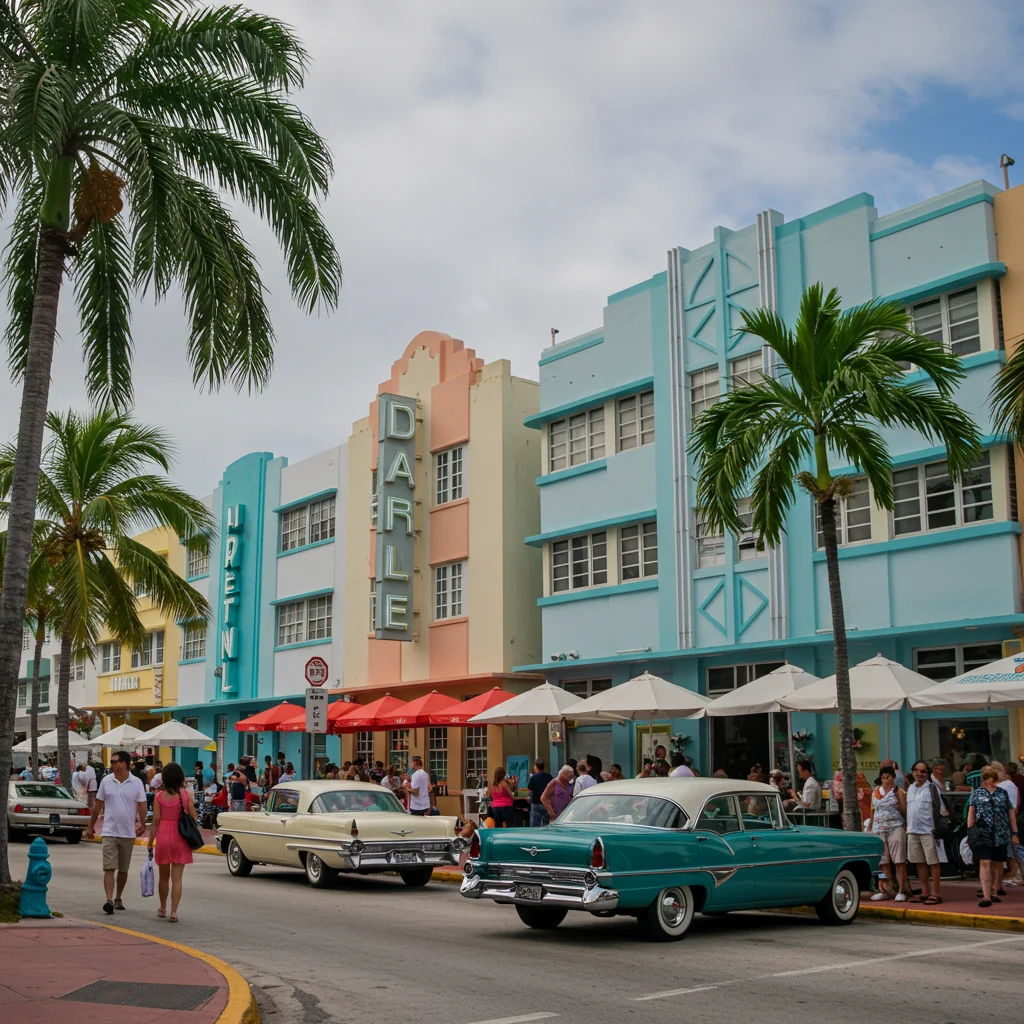
We recommend making time to visit several key sites during our tour. These buildings offer excellent photo opportunities and often house popular hotels, restaurants, or bars where we can pause and soak in the atmosphere.
The Colony Hotel: A Miami Icon
The Colony Hotel stands as one of the most photographed buildings in Miami Beach. Built in 1935, its striking blue neon sign and symmetrical facade make it instantly recognizable. The hotel has been featured in numerous films and television shows, further cementing its status as a symbol of Ocean Drive.
Today, The Colony operates as a boutique hotel, welcoming guests from around the world. Even if we are not staying overnight, the exterior alone is worth a visit, especially at night when the neon lights bring the building to life.
The Clevelander: History and Nightlife
The Clevelander is another landmark that has helped shape the character of Ocean Drive. Opened in 1938, it is famous for its lively outdoor bar, pool parties, and regular live entertainment. The Clevelander’s streamlined, curving architecture exemplifies the Miami Art Deco style.
For those interested in Miami’s nightlife, The Clevelander is a must-see. It offers a unique blend of history and contemporary fun, providing a taste of both the past and present. Even daytime visitors can enjoy the ambiance from the sidewalk cafe.
The Park Central Hotel: A Restored Gem
The Park Central Hotel, often referred to as the “Blue Jewel,” dates back to 1937. Its recently restored facade features classic Art Deco details such as porthole windows and decorative railings. The hotel played a significant role in Miami Beach’s early days as a luxury destination.
Today, The Park Central continues to welcome guests, offering a blend of historic charm and modern comfort. Its location right on Ocean Drive makes it an excellent base for exploring the district.
Lummus Park: The Heart of Ocean Drive
Lummus Park stretches along the eastern side of Ocean Drive, providing a lush, green buffer between the historic buildings and the sandy beach. The park is a favorite gathering spot for both locals and tourists, offering walking paths, volleyball courts, and shaded picnic areas.
Lummus Park is also the setting for many of Miami Beach’s most popular events. Its proximity to the ocean and Art Deco buildings creates a picturesque backdrop for photos and relaxation. We recommend spending some time here to enjoy the scenery and people-watching opportunities.
What Architectural Features Define Miami Art Deco?
Miami’s Art Deco architecture is instantly recognizable thanks to several defining features. These design elements set the district apart from other Art Deco sites around the world, reflecting both the city’s climate and its optimistic spirit.
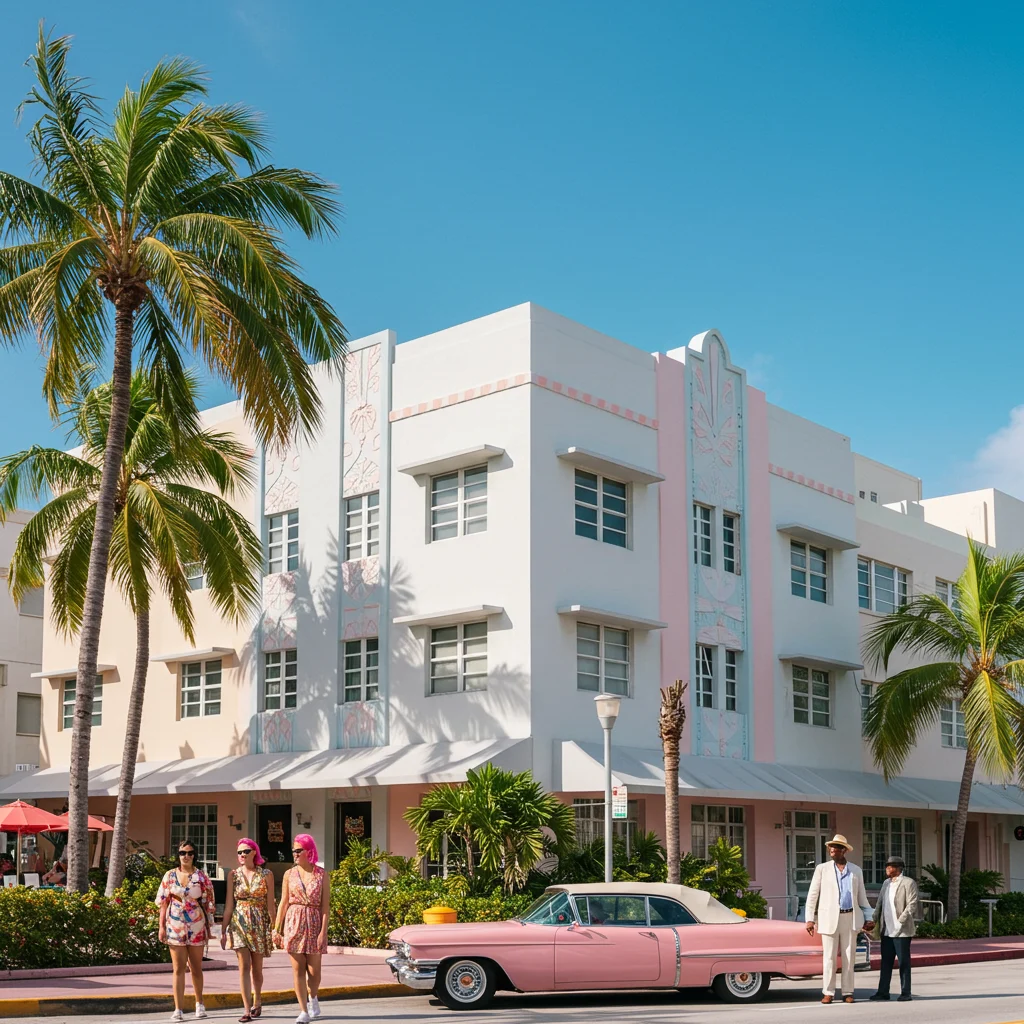
Understanding these features helps us appreciate the artistry and intention behind each building. As we tour the district, we can look for these hallmarks that make Miami’s Art Deco so distinctive.
Pastel Colors and Geometric Shapes
One of the most striking aspects of Miami’s Art Deco is its use of pastel colors. Soft blues, pinks, yellows, and greens dominate the facades, creating a cheerful and inviting atmosphere. These colors were chosen to complement the city’s tropical environment and abundant sunshine.
Geometric shapes are another signature element. Facades often feature zigzags, chevrons, and symmetrical patterns that draw the eye. These shapes give the buildings a dynamic, forward-looking quality, reflecting the optimism of the era in which they were built.
Nautical Motifs and Tropical Accents
Miami’s coastal location influenced the decorative details of its Art Deco buildings. Nautical motifs such as porthole windows, ship-like railings, and marine-inspired reliefs are common. These elements evoke the glamour of ocean liners and the allure of seaside living.
Tropical accents add a local flavor, with stylized palm trees, flamingos, and sunbursts appearing in both exterior and interior designs. These motifs celebrate Miami’s natural beauty and contribute to the district’s playful, vacation-like feel.
Streamlined Forms and Curved Corners
Streamlined forms are a hallmark of Miami’s Art Deco style. Many buildings feature rounded corners, horizontal lines, and smooth, aerodynamic shapes. These design choices reflect the influence of the Machine Age and the fascination with speed and modern technology.
The curved corners and ribbon windows create a sense of movement and fluidity. These features not only look stylish but also help the buildings withstand the region’s strong winds and tropical storms.
How to Take a Self-Guided Art Deco Walking Tour
One of the best ways to appreciate Miami’s Art Deco District is on foot. A self-guided walking tour lets us move at our own pace, linger where we like, and focus on the buildings and details that interest us most. With a bit of planning, we can see the highlights and uncover hidden gems along the way.
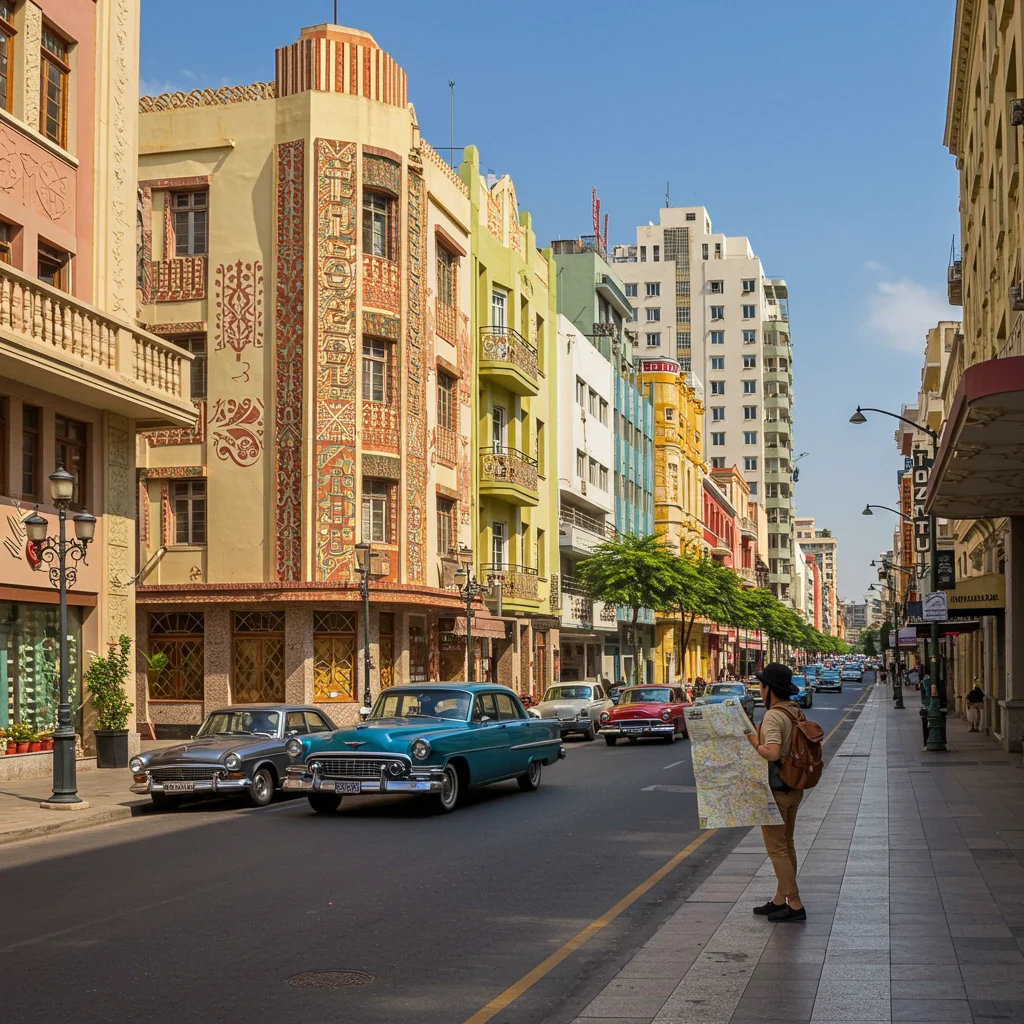
Here, we share tips on where to start, suggested routes, and advice for capturing the best photos of these historic treasures.
Where to Start Your Walking Tour
The ideal starting point for a self-guided Art Deco walking tour is the Art Deco Welcome Center, located at 1001 Ocean Drive. This center offers maps, brochures, and helpful information about the district’s history and architecture.
From the Welcome Center, we can easily access the most famous buildings on Ocean Drive as well as nearby streets rich in Art Deco character. Taking a few minutes to orient ourselves here will make the rest of our tour more enjoyable and informative.
Suggested Walking Routes for First-Time Visitors
For first-time visitors, a simple loop along Ocean Drive between 5th and 15th Streets covers many of the district’s most iconic landmarks. This route includes The Colony Hotel, The Clevelander, The Park Central Hotel, and Lummus Park.
We can extend our walk onto Collins Avenue and Washington Avenue to see additional Art Deco gems. These streets offer a quieter, less crowded experience while still showcasing the district’s architectural highlights.
If time allows, consider exploring Espanola Way for its Mediterranean-inspired buildings and lively atmosphere. Each of these routes provides a different perspective on Miami Beach’s architectural heritage.
Tips for Photographing Art Deco Buildings
Capturing the beauty of Miami’s Art Deco buildings requires a bit of strategy. Early morning and late afternoon offer the best natural light, highlighting the pastel colors and intricate details without harsh shadows.
Wide-angle lenses are helpful for photographing entire facades, while zoom lenses can bring out decorative features such as reliefs and railings. Don’t forget to include people, palm trees, or classic cars in your shots for added context and interest.
Respect private property and avoid blocking sidewalks when setting up your shots. Sharing your best photos on social media can inspire others and showcase the district’s unique charm.
Guided Tours: Should You Join One?
While self-guided tours offer flexibility, joining a guided tour can deepen our understanding of Miami’s Art Deco District. Knowledgeable guides share stories, historical context, and architectural insights that we might miss on our own.
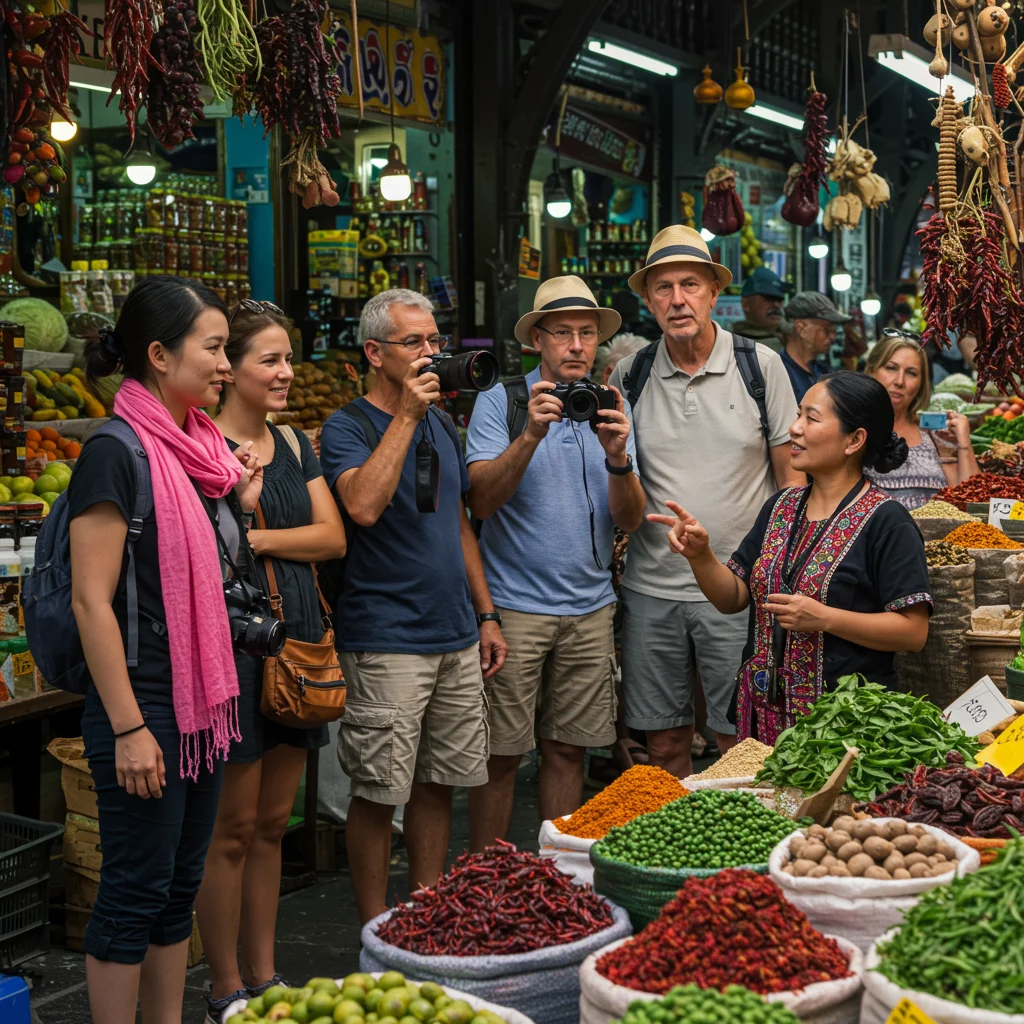
Guided tours come in various formats, from walking groups to bike and Segway excursions. Each option has its advantages, depending on our interests and energy level.
Top-Rated Art Deco Guided Tours in Miami
Several organizations offer highly regarded Art Deco tours in Miami Beach. The Miami Design Preservation League conducts daily walking tours led by trained guides, providing a thorough introduction to the district’s history and architecture.
Other companies offer themed tours, such as nighttime walks or art-focused excursions. Some even include access to building interiors or rooftop views, giving us a unique perspective on the area.
When choosing a tour, consider the group size, duration, and specific topics covered. Reading recent reviews can help us find a tour that matches our interests and expectations.
What to Expect on a Guided Tour
Most guided tours begin at the Art Deco Welcome Center or a nearby landmark. Guides typically provide background on the development of Miami Beach, the evolution of Art Deco, and the stories behind specific buildings.
We can expect to learn about architectural features, famous residents, and preservation efforts. Tours often include plenty of opportunities for questions and photos. Some may also incorporate stops at local cafes or shops, allowing us to experience the district’s contemporary culture.
Joining a guided tour is an excellent way to meet fellow travelers and gain a deeper appreciation for the area’s unique character.
Comparing Walking, Bike, and Segway Tours
Walking tours are the most traditional way to experience the Art Deco District. They allow us to move at a leisurely pace and focus on architectural details. Walking is suitable for most fitness levels and provides ample opportunities for photos and conversation.
Bike tours cover more ground in less time, making them ideal for those who want to see both Ocean Drive and outlying areas like Collins Avenue or Española Way. Segway tours offer a fun, high-tech alternative, combining mobility with expert commentary.
Each tour type has its own advantages. Consider our preferred pace, comfort level, and interests when selecting the right option for our visit.
If we are interested in activities beyond architecture, such as outdoor adventures, we might also enjoy checking out vibrant tours beyond the beach in Miami for a different perspective on the city.
Beyond Ocean Drive: Exploring More of Miami Beach’s Art Deco
While Ocean Drive is the most famous stretch of Miami’s Art Deco District, the architectural gems extend well beyond its borders. Streets like Española Way, Washington Avenue, and Collins Avenue offer additional opportunities to appreciate the city’s rich design heritage.
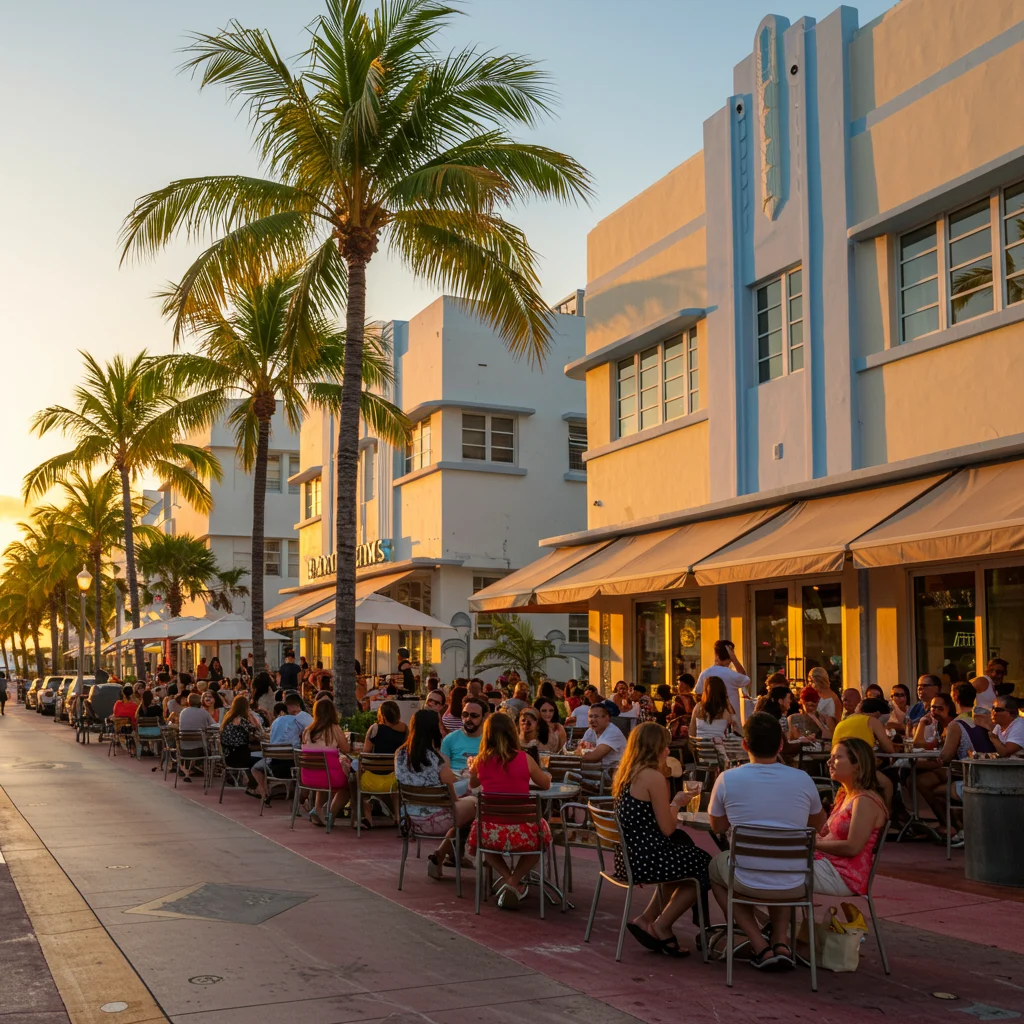
Each area brings its own flavor to the district, from Mediterranean influences to hidden treasures that reward those willing to venture off the main path.
Espanola Way: Mediterranean Meets Art Deco
Espanola Way is a charming, pedestrian-friendly street just a few blocks from Ocean Drive. Its architecture blends Mediterranean Revival with Art Deco, creating a unique atmosphere reminiscent of European villages.
The street is lined with cafes, galleries, and boutiques, making it a popular spot for both daytime strolls and evening outings. Colorful facades, decorative archways, and shaded courtyards provide plenty of photo opportunities and a break from the busier avenues nearby.
Washington Avenue: Hidden Art Deco Treasures
Washington Avenue runs parallel to Ocean Drive and is home to several lesser-known Art Deco buildings. This street offers a quieter, more local experience, with a mix of historic hotels, theaters, and small shops.
Notable landmarks include the Cameo Theater and the Miami Beach Post Office, each featuring distinctive Art Deco details. Exploring Washington Avenue lets us appreciate the district’s depth and variety beyond the most famous tourist spots.
Collins Avenue: The Strip of Splendor
Collins Avenue is another essential stop for Art Deco enthusiasts. Stretching north from South Beach, this avenue features some of the city’s grandest hotels and residential buildings. The architecture here reflects both Art Deco and later styles such as Miami Modern (MiMo).
Highlights include The National Hotel, The Delano, and The Ritz-Carlton South Beach. Walking along Collins Avenue gives us a sense of Miami’s evolution and ongoing commitment to design excellence.
For those interested in combining architectural sightseeing with adventure, consider taking a break for some water sports. Our guide on jet ski adventures in Miami offers some exciting options nearby.
Art Deco Weekend: Miami’s Annual Celebration
Each year, Miami Beach hosts Art Deco Weekend, a festival dedicated to celebrating the district’s architectural and cultural legacy. This event attracts thousands of visitors and offers a packed schedule of activities for all ages.
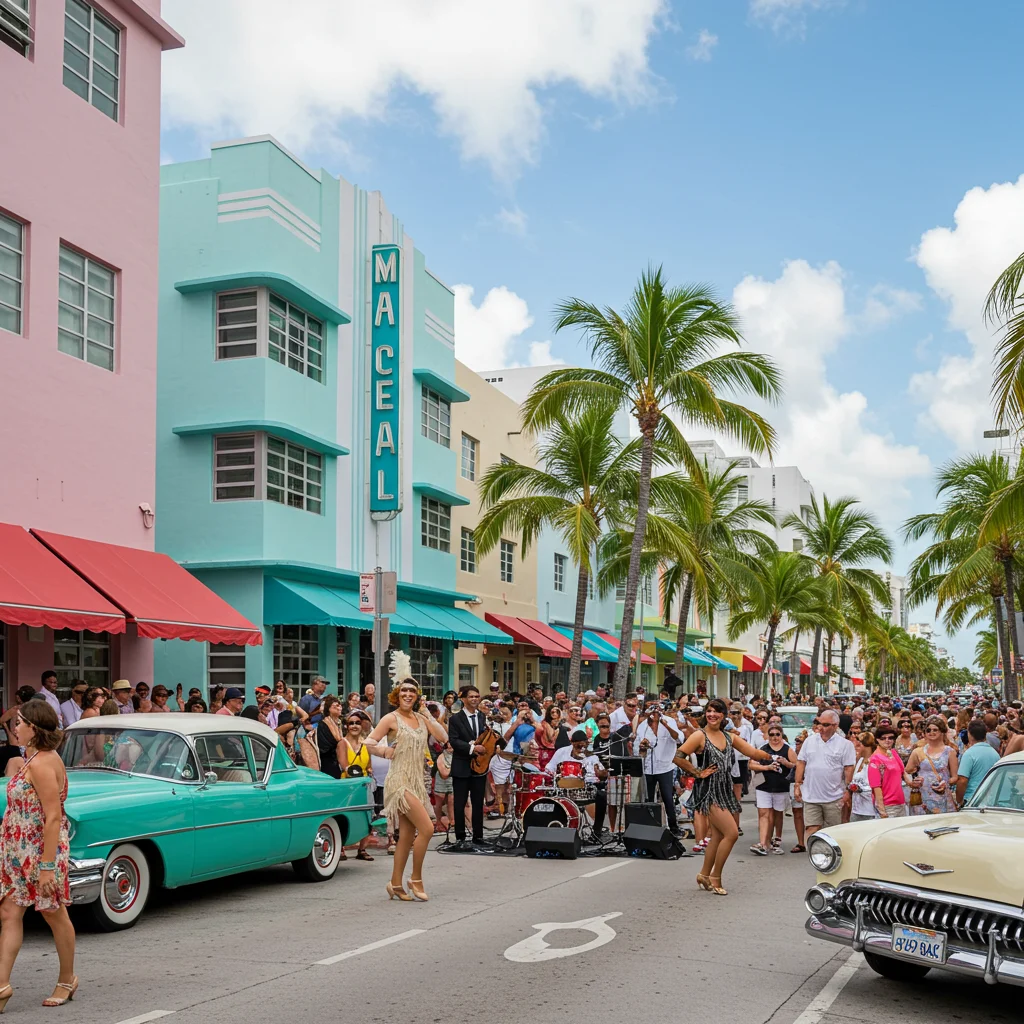
Art Deco Weekend is a highlight of the Miami calendar, providing a unique chance to experience the district in a festive, community-oriented setting. It’s an excellent time for us to learn, connect, and enjoy the best of Ocean Drive and beyond.
What Happens During Art Deco Weekend?
Art Deco Weekend features guided tours, live music, vintage car shows, and lectures on design and history. Street markets, food stalls, and art exhibitions add to the lively atmosphere. Many buildings open their doors for special events or behind-the-scenes access during the festival.
The event also includes family-friendly activities, film screenings, and costume contests. The entire district comes alive with color and energy, making it a memorable time to visit Miami Beach.
How to Participate in Art Deco Festival Events
Most Art Deco Weekend events are open to the public and free of charge, though some tours or workshops may require advance registration. We recommend checking the official festival website for a schedule of activities and any ticketing information.
Arriving early and planning our route can help us make the most of the festival. Comfortable clothing, sunscreen, and a camera are essentials for enjoying the day. Participating in guided tours or lectures can deepen our appreciation for the district’s history and design.
Dining on Ocean Drive: Where to Eat and Drink
Ocean Drive is as much a culinary destination as it is an architectural one. The avenue is lined with restaurants, cafes, and bars offering everything from casual snacks to fine dining. Eating here is part of the Miami Beach experience, with many venues featuring outdoor seating and ocean views.
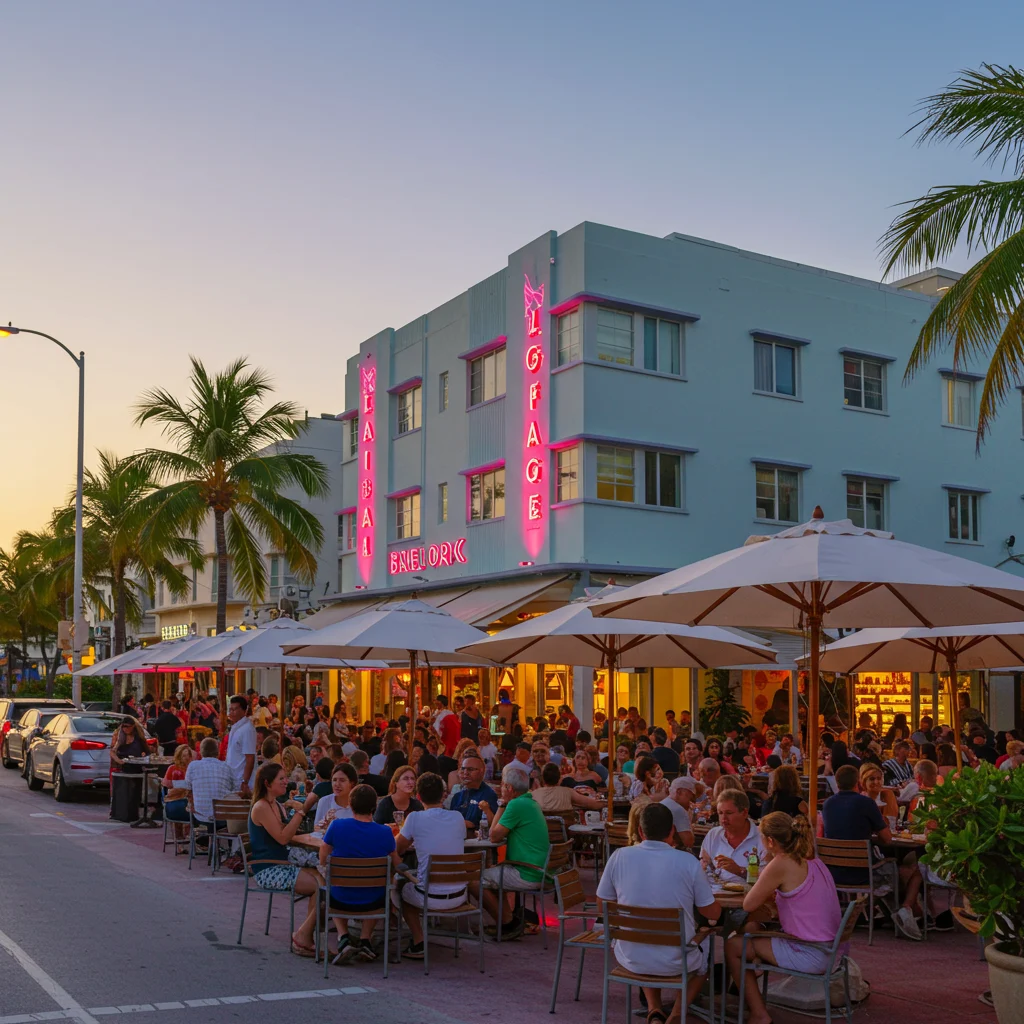
We recommend sampling a variety of local and international flavors during our visit. Here are some top picks for breakfast, lunch, dinner, and nightlife.
Best Breakfast Spots with a View
Starting our day with breakfast on Ocean Drive is a treat. Many cafes offer al fresco seating, letting us enjoy the morning sun and people-watching. The Front Porch Cafe is a local favorite, known for its hearty breakfasts and beachfront location.
News Cafe, another iconic spot, has served locals and visitors since 1988. Its outdoor tables are perfect for coffee and pastries while taking in the Art Deco scenery. These venues offer both classic and creative breakfast options to suit any taste.
Lunch and Dinner: Iconic Restaurants and Cafes
For lunch or dinner, Ocean Drive offers a wide range of choices. Gianni’s at The Villa, located in the former Versace Mansion, provides an elegant setting and upscale Italian fare. For something more casual, The Carlyle Cafe serves American and international dishes in a classic Art Deco setting.
Many restaurants feature fresh seafood, Latin-inspired cuisine, and Miami’s signature cocktails. We recommend checking menus and prices before sitting down, as some venues can be pricier due to their prime location.
Where to Find the Best Cocktails and Nightlife
Ocean Drive is famous for its nightlife, with bars and lounges offering everything from craft cocktails to live music. The Clevelander is a top pick for those seeking a lively atmosphere and signature drinks. Mango’s Tropical Cafe is another hotspot, known for its energetic shows and Latin-inspired cocktails.
Many venues offer happy hour specials and outdoor seating. Whether we are looking for a quiet drink or a night of dancing, Ocean Drive has options to suit every mood.
If we are interested in combining nightlife with adventure, nearby water activities such as renting a jet ski and exploring the Miami coastline can add excitement to our itinerary.
Shopping in the Art Deco District
Shopping is another highlight of visiting the Art Deco District. The area features a mix of independent boutiques, souvenir shops, and art galleries, making it easy to find unique gifts and mementos.
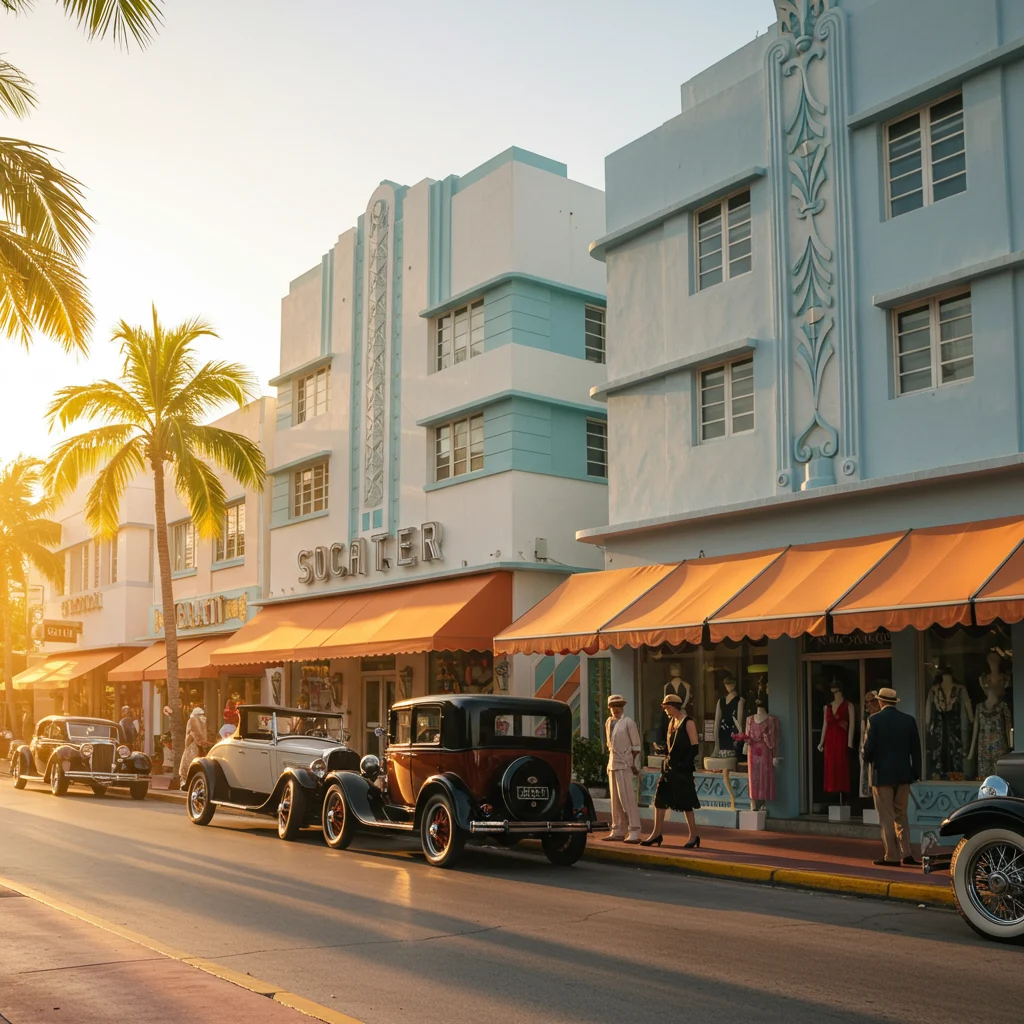
We can browse for everything from designer clothing to vintage memorabilia, all within a short walk of Ocean Drive. Shopping here supports local businesses and lets us take a piece of Miami’s style home with us.
Boutiques and Souvenir Shops
The Art Deco District is home to a variety of boutiques offering clothing, jewelry, and accessories. Many specialize in Miami-inspired designs, making them ideal for unique souvenirs. Shops along Ocean Drive and Collins Avenue cater to a range of tastes and budgets.
Souvenir shops sell everything from postcards and t-shirts to beachwear and home decor. These stores are perfect for picking up last-minute gifts or keepsakes to remember our trip.
Where to Buy Art Deco Memorabilia
For those interested in Art Deco memorabilia, several specialty stores carry posters, books, and collectibles featuring Miami’s historic architecture. The Art Deco Welcome Center gift shop is a reliable source for high-quality items, including prints and replicas of famous buildings.
Local markets and antique shops occasionally offer vintage finds such as glassware, lighting fixtures, and original artwork from the district’s heyday. These treasures make for meaningful souvenirs and conversation pieces.
Local Art Galleries and Studios
Art lovers will appreciate the district’s galleries and studios, which showcase both local and international talent. Many galleries focus on contemporary art, photography, and design, providing a modern counterpoint to the area’s historic architecture.
Regular exhibitions, artist talks, and workshops create a dynamic arts scene. Visiting a gallery or studio can offer inspiration and insight into Miami’s creative community.
If you are interested in historic walking tours in other destinations, our guide on walking through Old San Juan’s history provides another enriching experience.
Ocean Drive at Night: What to Expect
Ocean Drive takes on a new personality after dark. The neon lights, bustling crowds, and live entertainment create an electric atmosphere that is distinct from the daytime scene.
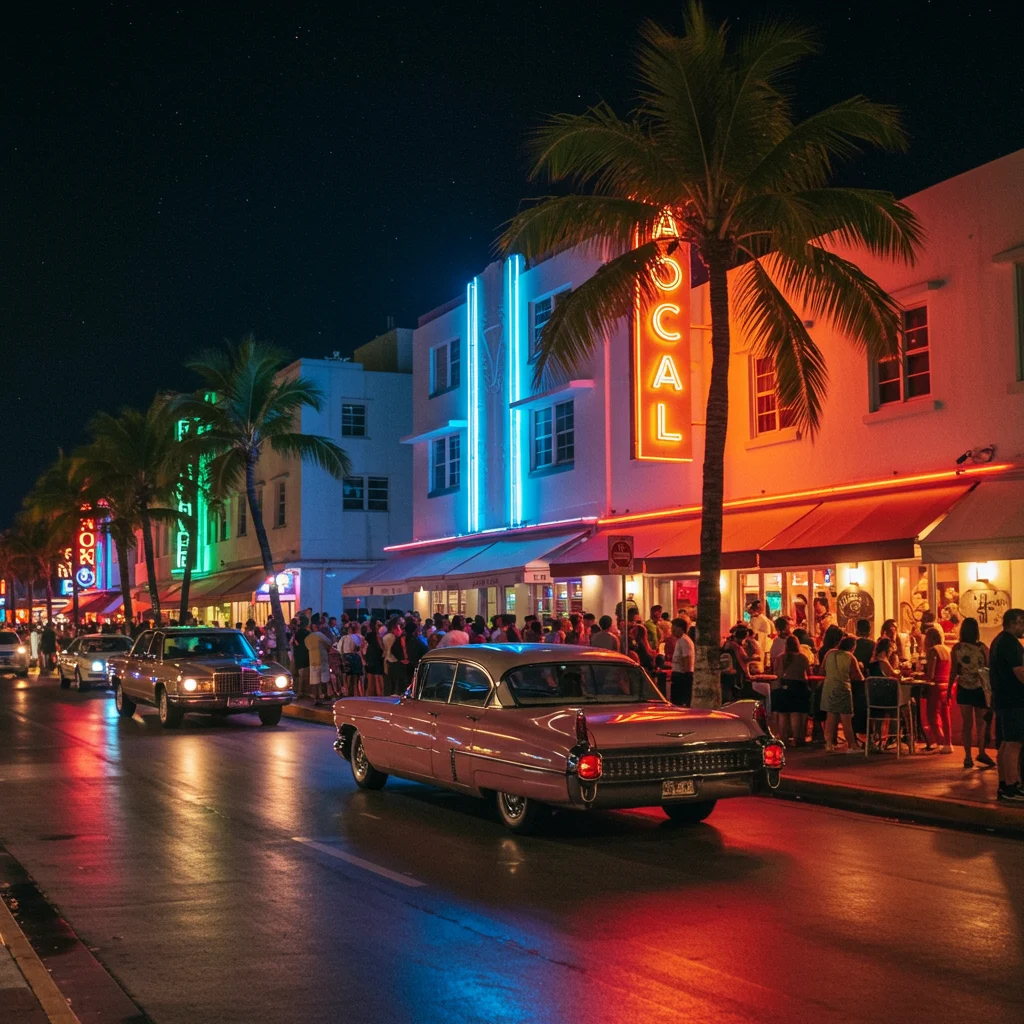
Nighttime is the perfect opportunity to appreciate the district’s illuminated buildings, enjoy live music, and experience Miami’s famous nightlife. With a bit of preparation, we can make the most of our evening on Ocean Drive.
Nighttime Light Shows and Illuminated Buildings
One of the highlights of Ocean Drive at night is the way its Art Deco buildings come alive with light. Neon signs, colored uplighting, and illuminated facades create a dazzling display that is both nostalgic and modern.
Many hotels and restaurants enhance their lighting at night, making the street a favorite spot for evening walks and photography. The interplay of color and shadow highlights the district’s architectural features in a new way.
Live Music and Entertainment Venues
Live music is a staple of Ocean Drive’s nightlife. Many bars and clubs feature local bands, DJs, and dancers, creating a lively soundtrack for the evening. Mango’s Tropical Cafe and The Clevelander are two of the most popular spots for live entertainment.
Street performers and pop-up shows add to the festive atmosphere. Whether we are looking for jazz, salsa, or contemporary beats, Ocean Drive offers something for every musical taste.
Safety Tips for Nighttime Visitors
While Ocean Drive is generally safe, it is wise to take standard precautions when visiting at night. Stick to well-lit areas, travel in groups if possible, and keep an eye on personal belongings. Be cautious when crossing busy streets, as traffic can be heavy during peak hours.
If using ride-sharing services, confirm the driver’s identity before entering the vehicle. Most importantly, enjoy the vibrant atmosphere while staying aware of our surroundings.
Family-Friendly Activities in the Art Deco District
The Art Deco District is not just for adults. Families will find plenty of activities and attractions suitable for children of all ages. From interactive museums to outdoor parks, there are many ways to enjoy Miami Beach as a family.
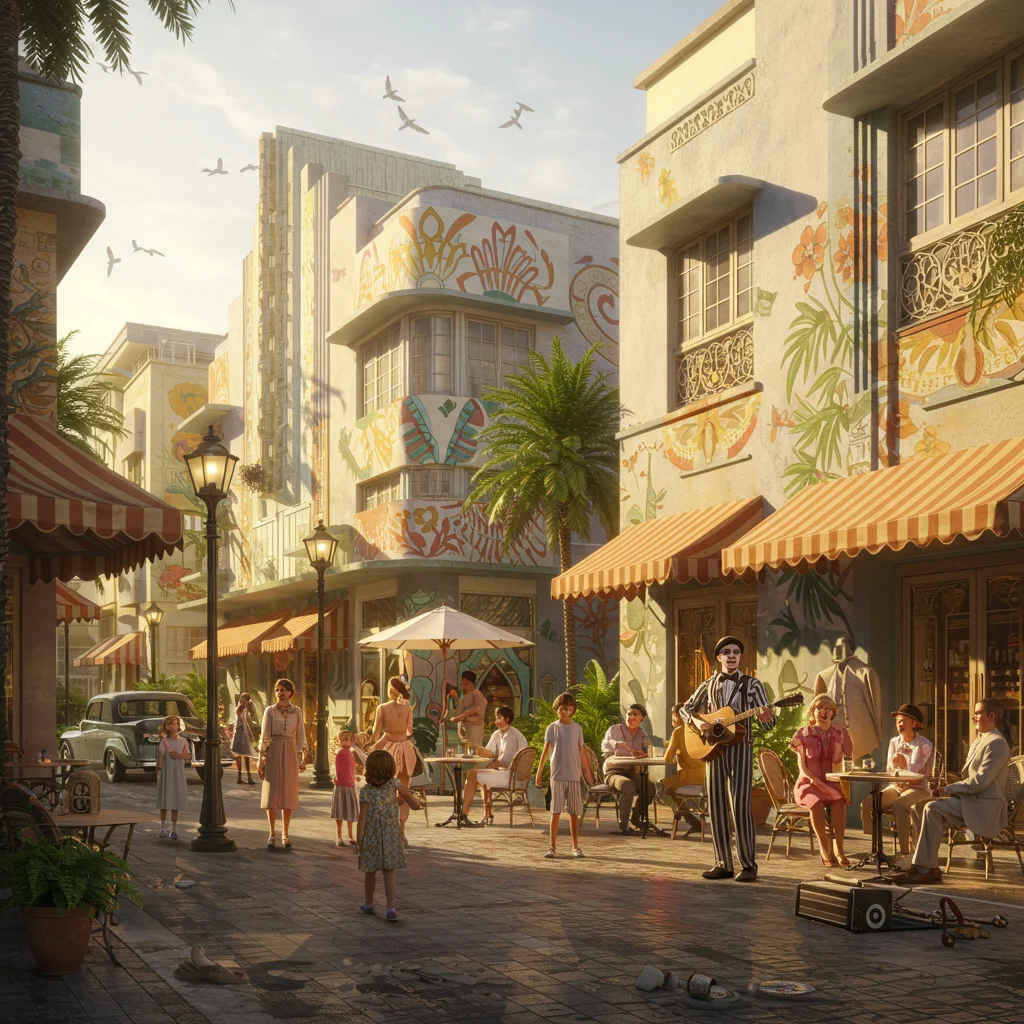
Planning ahead and choosing age-appropriate activities can help ensure that everyone has a memorable visit.
Kid-Friendly Museums and Attractions
The Miami Children’s Museum, located a short drive from South Beach, offers hands-on exhibits and educational programs for young visitors. The Wolfsonian-FIU Museum, while focused on design and history, also features interactive displays that engage children and teens.
Many Art Deco walking tours welcome families and provide kid-friendly commentary. Special events and workshops during Art Deco Weekend may also be geared toward younger audiences.
Parks and Outdoor Spaces for Families
Lummus Park is an excellent choice for families, with its open lawns, playgrounds, and easy beach access. The park hosts regular events and activities for children, making it a favorite spot for local families as well.
Nearby South Pointe Park offers walking trails, picnic areas, and splash pads. These outdoor spaces provide a welcome break from sightseeing and a chance for kids to burn off energy.
Accessibility: Touring Miami’s Art Deco for All
Miami Beach is committed to making the Art Deco District accessible to visitors of all abilities. Many sidewalks, public buildings, and attractions are designed to accommodate wheelchairs and mobility devices.
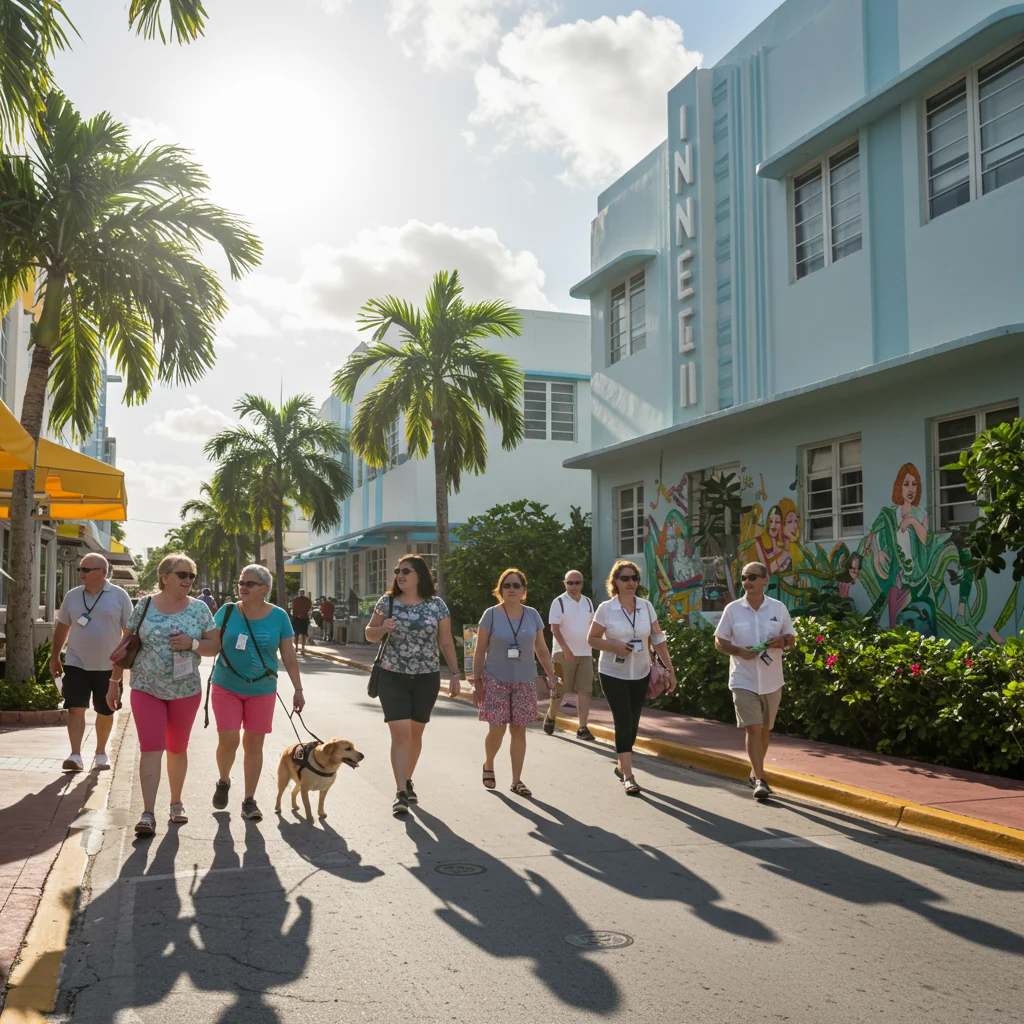
Planning ahead and knowing what resources are available can help ensure a comfortable and enjoyable visit for everyone.
Wheelchair-Accessible Routes and Facilities
Most of Ocean Drive and the surrounding streets feature curb cuts, ramps, and smooth sidewalks suitable for wheelchairs and strollers. Public restrooms and many hotels are also accessible, though it is always a good idea to confirm in advance.
Some guided tours offer accommodations for guests with mobility challenges. The Art Deco Welcome Center provides information on accessible routes and attractions, making it a helpful first stop for visitors with special needs.
Resources for Visitors with Disabilities
Miami Beach’s visitor website and the Art Deco Welcome Center offer detailed guides and maps highlighting accessible entrances, restrooms, and services. Many hotels and restaurants are equipped with elevators, ramps, and accessible seating.
For additional assistance, local organizations and city services are available to answer questions and provide support. Planning ahead and communicating any specific needs can help ensure a smooth and enjoyable visit.
Tips for Sustainable and Respectful Tourism
As visitors to Miami’s historic Art Deco District, we have a responsibility to support the local community and protect the area’s unique heritage. Practicing sustainable and respectful tourism benefits both residents and future travelers.

Here are some practical ways to make a positive impact during our trip.
How to Support Local Businesses
Choosing to shop, dine, and stay at locally owned businesses helps sustain the character and economy of the Art Deco District. Many independent stores, cafes, and hotels rely on visitor support to thrive.
Attending local events, purchasing from artisans, and leaving positive reviews online are additional ways to contribute. By supporting local businesses, we help preserve the vibrant culture that makes Miami Beach special.
Respecting Historic Buildings and Neighborhoods
Many of the district’s buildings are nearly a century old and require ongoing care. We should avoid touching or leaning on delicate facades, and never remove or damage decorative elements.
Following posted guidelines, staying on designated paths, and disposing of litter responsibly all help protect the area. Respecting the privacy of residents and businesses also ensures a positive experience for everyone.
Capturing Your Experience: Photography and Social Media Tips
Miami’s Art Deco District is one of the most photogenic places in the country. Sharing our experiences through photography and social media not only creates lasting memories but also inspires others to appreciate this unique destination.
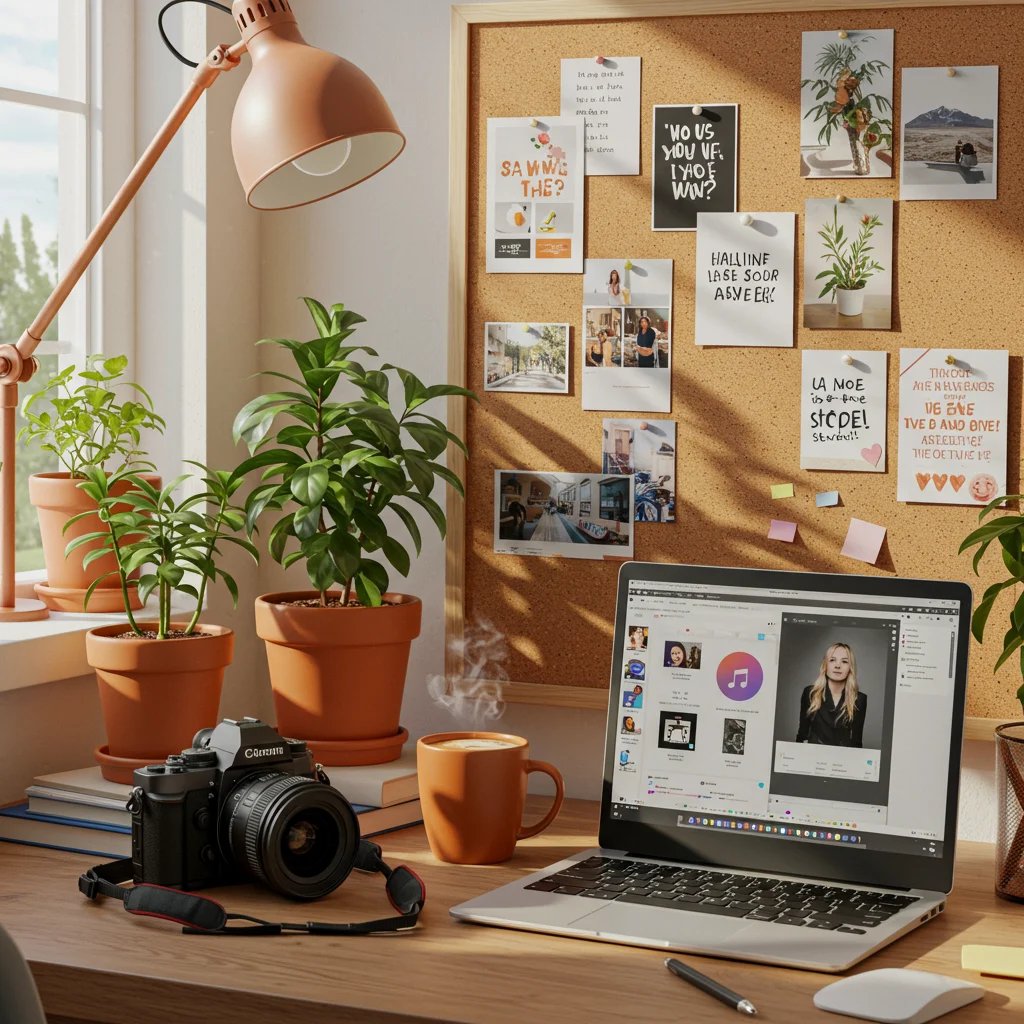
Here are some tips for capturing and sharing our favorite moments during our visit.
Best Instagram Spots on Ocean Drive
Certain locations on Ocean Drive are particularly popular with photographers and social media enthusiasts. The neon-lit facade of The Colony Hotel, the pastel curves of The Park Central Hotel, and the palm-lined paths of Lummus Park all make for striking images.
Sunrise and sunset offer dramatic lighting, while nighttime brings out the district’s iconic neon glow. Including people, classic cars, or street performers in our shots can add a lively, authentic touch.
How to Take Unique Art Deco Photos
To create standout photos, try capturing details such as geometric patterns, decorative reliefs, and unusual perspectives. Experiment with reflections in windows or puddles, and use leading lines to draw the viewer’s eye through the frame.
Editing tools and filters can enhance the pastel colors and sharp contrasts typical of Art Deco architecture. When sharing on social media, tagging locations and using relevant hashtags can help connect with fellow enthusiasts.
Frequently Asked Questions About Touring Miami’s Art Deco District
Many visitors have questions about how best to experience Miami’s Art Deco District. Here, we address some of the most common queries to help plan a smooth and enjoyable trip.
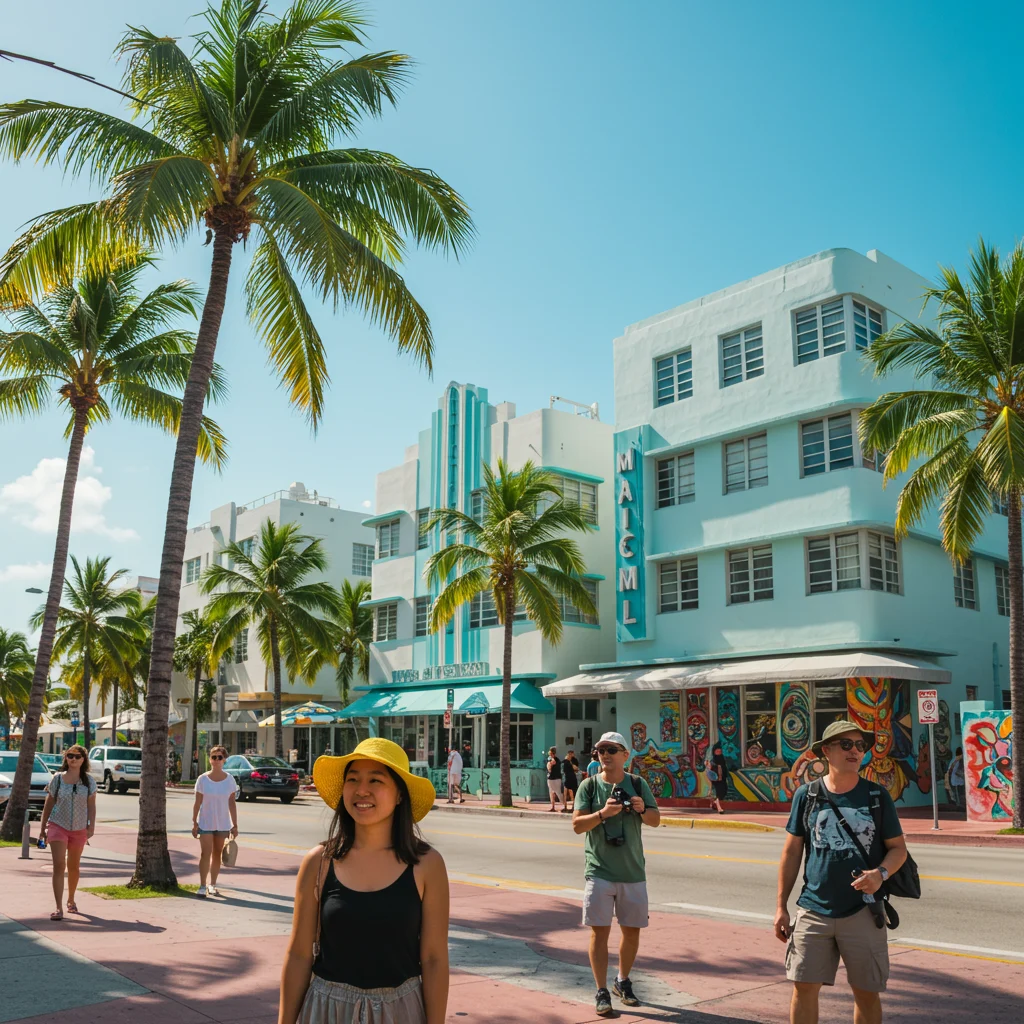
Whether we’re traveling solo, with family, or in a group, these answers provide practical information and peace of mind.
How Much Time Should You Spend on Ocean Drive?
The ideal amount of time to spend on Ocean Drive depends on our interests and schedule. For a thorough walking tour, including time for photos, shopping, and a meal, we recommend at least half a day. This allows us to see the major landmarks and soak in the atmosphere.
If we wish to explore surrounding streets, visit museums, or enjoy the beach, a full day is ideal. Those with a keen interest in architecture or history may want to allocate even more time to join guided tours and attend special events.
Is the Art Deco District Safe for Solo Travelers?
The Art Deco District is generally considered safe for solo travelers, especially during the day and early evening. The area is well-patrolled and busy with both locals and tourists. Standard precautions, such as staying aware of our surroundings and avoiding isolated areas at night, are recommended.
Solo travelers may find it enjoyable to join group tours or events, which provide social opportunities and added security. Miami Beach’s welcoming atmosphere makes it a great destination for those traveling alone.
Can You Visit the Interiors of Art Deco Buildings?
Some Art Deco buildings are open to the public, especially those that operate as hotels, restaurants, or shops. Guided tours may include access to lobbies, rooftop terraces, or select rooms, offering a closer look at interior details.
Private residences and certain hotels may restrict access to guests only. Always ask permission before entering non-public areas, and respect posted signs and staff instructions.
Conclusion: Making the Most of Your Miami Art Deco Adventure
Touring Miami’s Art Deco District and Ocean Drive is a rewarding experience for travelers of all backgrounds. The area offers a unique blend of history, architecture, culture, and entertainment that captures the essence of Miami Beach.
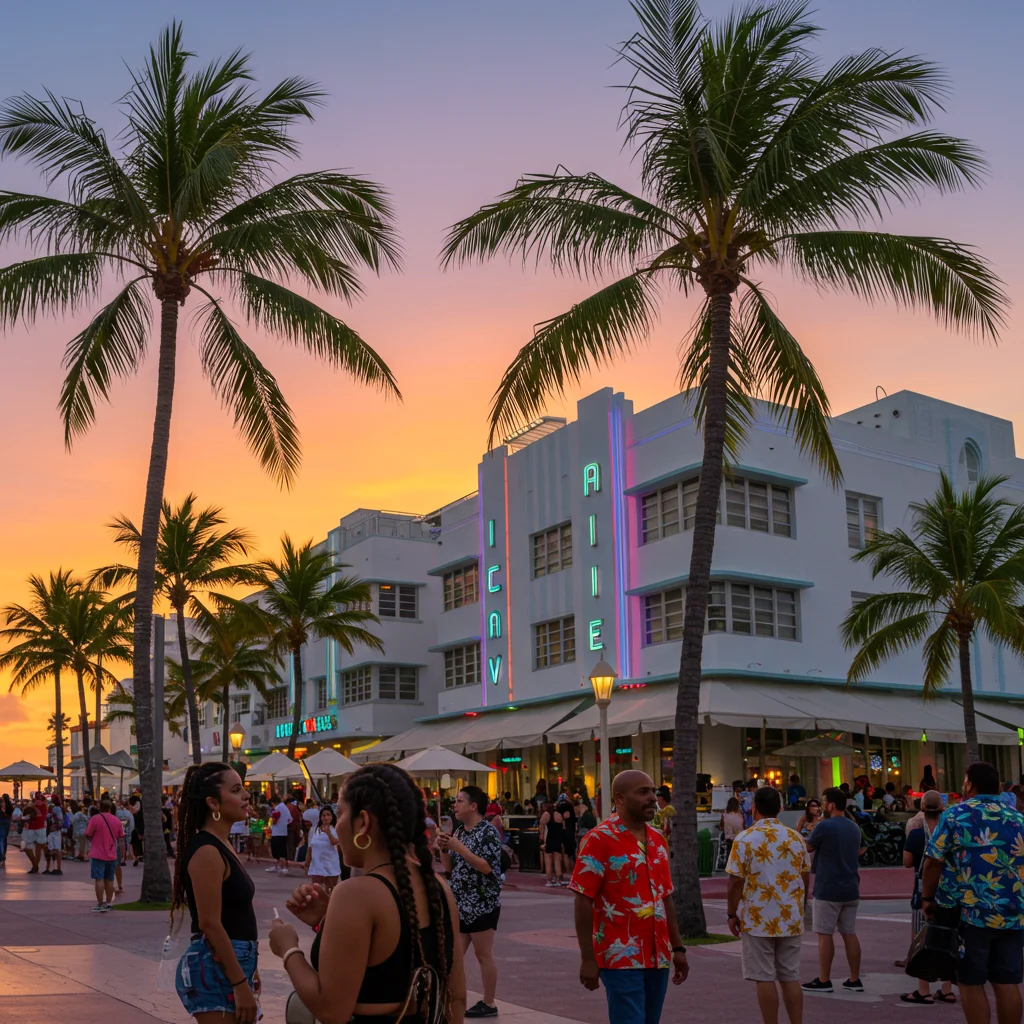
With thoughtful planning and a spirit of curiosity, we can enjoy everything from guided tours and culinary delights to vibrant nightlife and family-friendly activities. As we reflect on our visit, we gain a deeper appreciation for the vision and creativity that shaped this one-of-a-kind destination.
For more tips and curated experiences, we recommend checking out Tour Cuts to help plan your next Miami adventure.

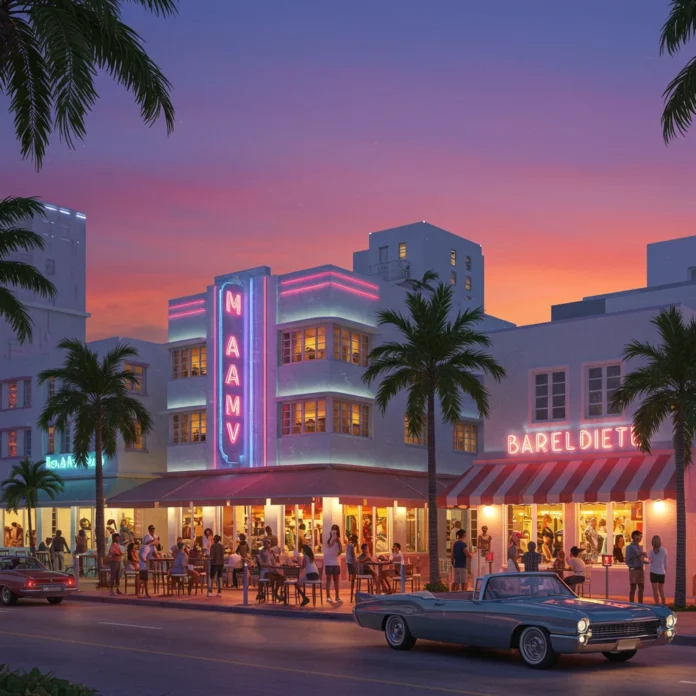
[…] Can I combine parasailing with other tours? Many operators offer package deals or recommendations for nearby attractions. For a broader view of Miami-area tours, see our guide on touring Miami’s Art Deco district and Ocean Drive. […]
[…] For a deeper look at this style, we recommend reading From Art Deco to Ocean Drive: Touring Miami Right. […]